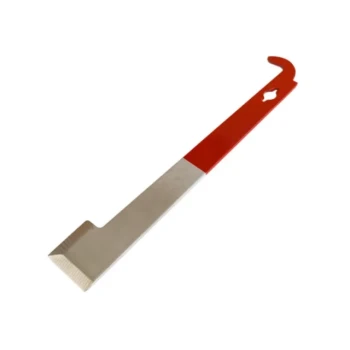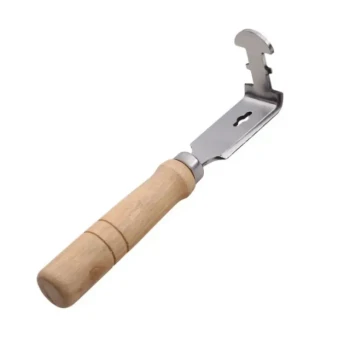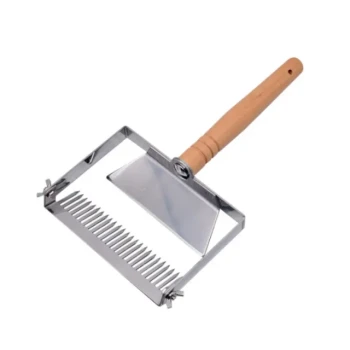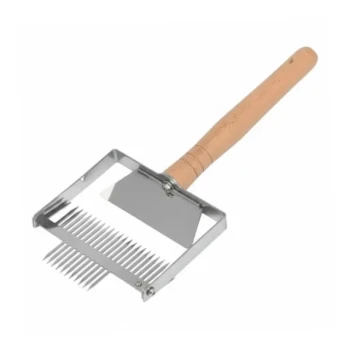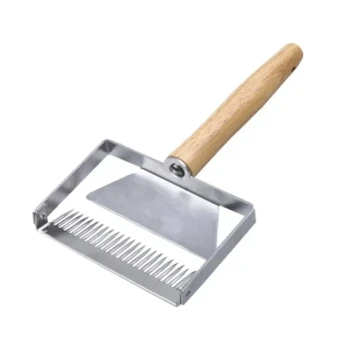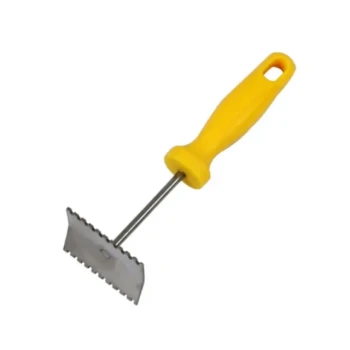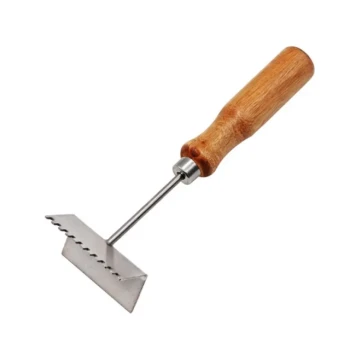To clean and sterilize a hive tool, you must first physically remove all wax and propolis by scraping and scrubbing, then kill any remaining pathogens. The most common sterilization methods involve either soaking the tool in a chemical solution like isopropyl alcohol or diluted bleach, or applying high heat with a blowtorch or by placing it in a hot smoker.
The critical distinction to understand is that cleaning removes visible debris, while sterilizing kills microscopic pathogens. One cannot be effective without the other; you must always clean your tool thoroughly before you can properly sterilize it to prevent disease transmission.

The Two-Step Process for Hive Biosecurity
A clean-looking tool is not necessarily a sterile one. Pathogens like the spores that cause American Foulbrood (AFB) can hide in microscopic crevices or under a thin layer of propolis, making a two-step approach essential for protecting your colonies.
Step 1: Thorough Physical Cleaning
This initial step is non-negotiable and focuses on removing all organic matter from the tool's surface.
First, use the edge of your tool to scrape off as much caked-on wax and propolis as possible.
Next, vigorously scrub the tool with a cleansing powder (like Comet) and a stainless-steel scrubber or steel wool. This abrasive action is necessary to remove the sticky resins that water alone cannot dissolve.
Finally, rinse the tool in clean water to wash away all the loosened debris and cleansing powder, leaving you with a physically clean surface ready for sterilization.
Choosing Your Sterilization Method
Once the tool is physically clean, you can proceed to the second step: killing any remaining bacteria, viruses, and fungal spores. The method you choose depends on your situation, risk level, and available equipment.
Heat Sterilization: The Gold Standard
Applying high heat is widely considered the most effective way to destroy resilient pathogens.
Use a blowtorch to heat the entire surface of the hive tool until it glows or for at least 30 seconds. This is the most reliable method for killing hardy AFB spores.
Alternatively, you can place the tool directly into the hot fire pot of your smoker and pump the bellows to increase the heat, achieving a similar sterilizing effect.
Chemical Sterilization: A Practical Alternative
When open flame is not practical, chemical soaks are a viable option.
After cleaning and rinsing, immerse the tool completely in rubbing alcohol (isopropyl alcohol). You can leave it soaking in a container between hive inspections.
A solution of diluted bleach can also be used, but the tool must be thoroughly rinsed with clean water afterward to remove any residue that could harm the bees.
Basic Sanitization: For Low-Risk Scenarios
For routine work within a single, healthy apiary, less intensive methods can suffice.
Running a hive tool through a dishwasher cycle provides a solid cleaning and sanitization with hot water.
For personal use where disease is not a present concern, simply washing thoroughly in hot, soapy water with a good scrubber and allowing it to air dry is a sufficient baseline.
Understanding the Trade-offs
Each method comes with its own set of advantages and disadvantages. Choosing the right one requires understanding their effectiveness and practicality.
Efficacy vs. Convenience
Flame sterilization is the most effective method, especially against resilient spores, and it is very fast. However, it requires carrying a blowtorch and fuel.
Chemical soaks are very convenient but require time for the chemical to work effectively and may be less reliable against the most persistent pathogens.
Safety and Equipment Care
Using a blowtorch involves an open flame and requires appropriate safety precautions. Constantly heating your tool to high temperatures can, over time, affect the temper of the steel.
Chemicals like bleach can be corrosive, and any residue must be completely rinsed off to ensure bee safety.
Making the Right Choice for Your Apiary
Your approach to tool hygiene should adapt to the specific task and the health status of your colonies.
- If your primary focus is routine inspections in a healthy yard: A thorough scrape and scrub, followed by a quick pass with a flame or a wipe with an alcohol-soaked rag between hives, is a practical and effective protocol.
- If you are inspecting a weak, dead, or potentially diseased hive: Do not move to another hive without first performing a complete sterilization using a blowtorch to prevent catastrophic disease spread.
- If you are doing an end-of-season deep clean: A thorough scrubbing followed by a dishwasher cycle or a prolonged soak in rubbing alcohol will prepare your tools for storage.
Adopting this simple two-step habit is a fundamental pillar of responsible and successful beekeeping.
Summary Table:
| Step | Purpose | Key Methods |
|---|---|---|
| 1. Cleaning | Remove visible wax & propolis | Scrape, scrub with abrasive powder, rinse |
| 2. Sterilizing | Kill microscopic pathogens | Blowtorch (heat), Isopropyl alcohol (chemical) |
Protect your investment and ensure the health of your colonies. Proper tool hygiene is fundamental to successful, responsible beekeeping. HONESTBEE supplies durable, easy-to-clean beekeeping tools and equipment to commercial apiaries and distributors. Our wholesale-focused operations ensure you get the reliable gear you need to maintain the highest biosecurity standards.
Contact HONESTBEE today to discuss your equipment needs and keep your apiary thriving.
Visual Guide
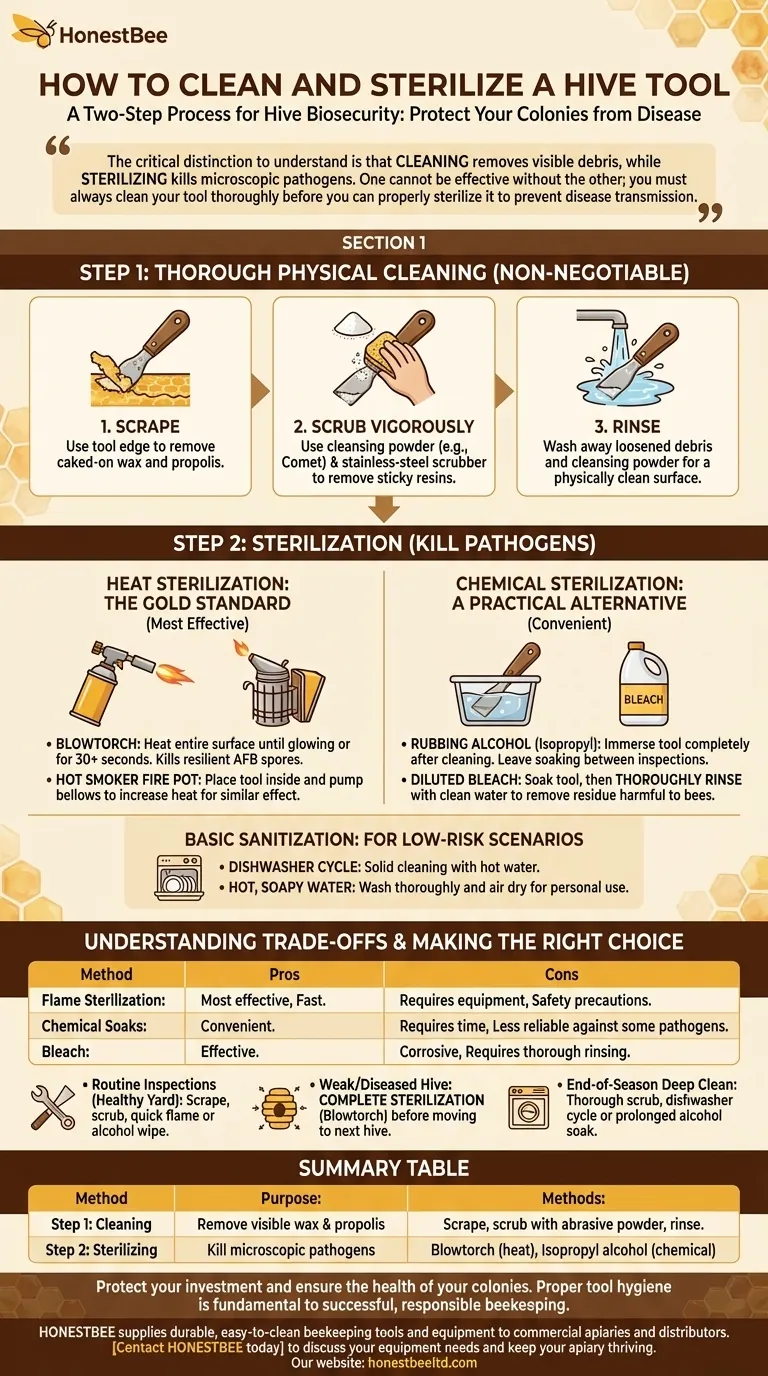
Related Products
- HONESTBEE Advanced Ergonomic Stainless Steel Hive Tool for Beekeeping
- Professional Dual-End Stainless Steel Hive Tool for Beekeeping
- Professional Stainless Steel J-Hook Hive Tool
- Professional Stainless Steel Frame Cleaner with Ergonomic Wood Handle
- Professional Wide Blade Honey Scraper for Beekeeping and Honey Processing
People Also Ask
- What are the features of a regular hive tool? The Essential Multi-Tool for Every Beekeeper
- Why do hive tools have a hole? Unlock the Secret to Efficient Beekeeping
- What are the basic tools for beekeeping? Essential Starter Kit for Safe & Successful Hive Management
- How is a hive tool used for scraping and cleaning? Master Hive Maintenance for a Healthy Colony
- What are some common uses of a hive tool? Essential Multi-Purpose Tool for Every Beekeeper


